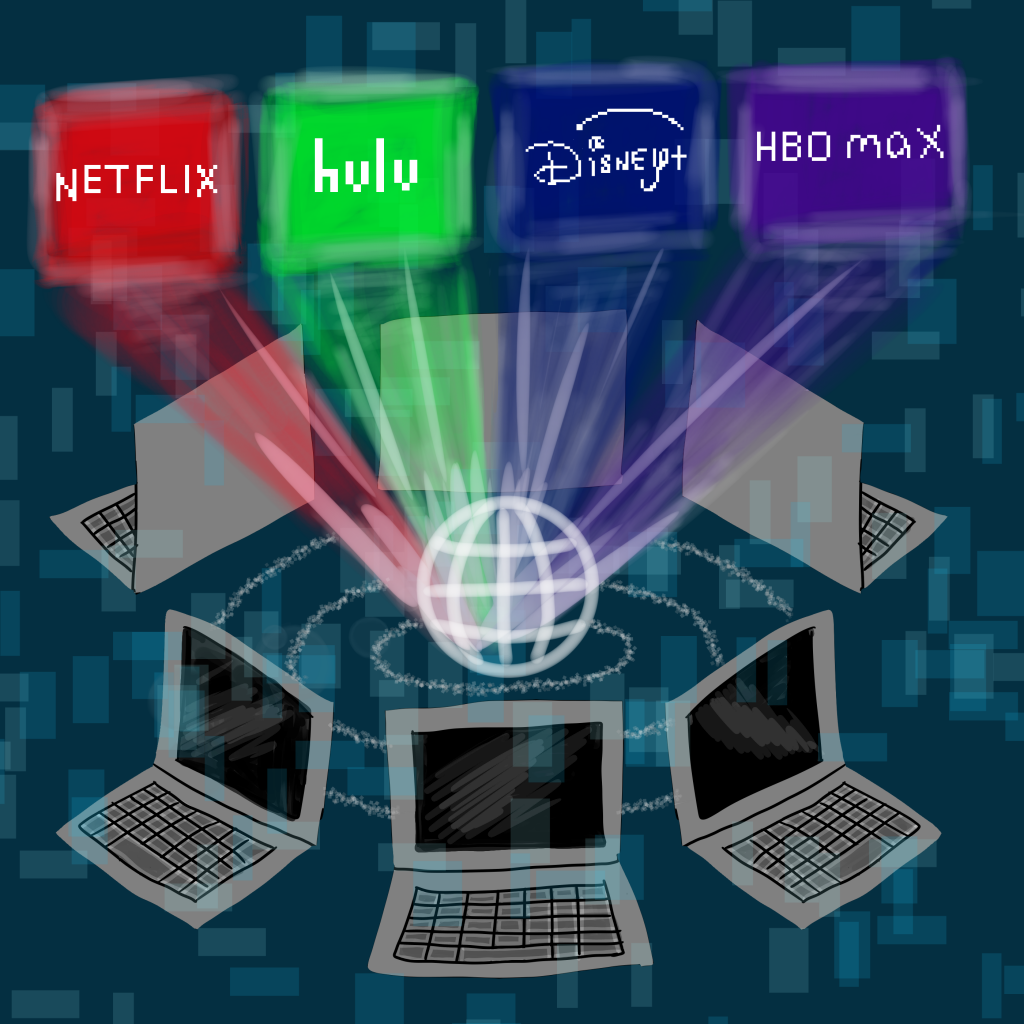Over the past few years, a variety of new streaming services have been popping up: Hulu, Amazon Prime, Disney+, HBO Max and more. On one hand, this gives viewers access to a wider variety of shows and movies. But on the other hand, to access the full range of content, the viewer now has to pay for several different platforms. Has the rise of new streaming platforms made watching shows and movies easier or more difficult than when Netflix was the only option?
When Netflix was founded in 1997, users could choose from about 1,000 movies to be mailed to their homes as DVDs. The site competed with video rental stores such as Blockbuster, making it easier for people to rent movies. Ten years later, in 2007, Netflix launched its first video streaming initiative, allowing subscribers to immediately watch any of 1,000 titles, while still maintaining its DVD mailing service. Since then, Netflix has only grown, reaching approximately 204 million subscribers worldwide in 2021. According to Cord Cutting, it now holds the rights to over 13,000 shows and movies worldwide, with over 5,000 in the U.S. library alone.
Despite Netflix’s monopoly over the streaming industry, or perhaps because of it, several new streaming services have risen over the past few years. Hopping onto the bandwagon of success, sites like Hulu and Disney+ have begun to hunt on Netflix’s territory. According to Cord Cutters, Hulu, launched in 2008, now has over 39 million subscribers in the United States. While it only offers about 2,700 titles, a little more than half of Netflix’s selection, it also offers faster updates of recently aired shows, leading to episodes of some shows released on Hulu the same day that they air. Disney+’s history is even more dramatic. Despite only launching in 2019, Disney+ already has almost 95 million subscribers, with content limited to shows and movies only produced by Disney.
Not only have newer streaming services begun offering similar services like Netflix, but they have also begun directly poaching shows from the platform. The wildly popular shows “The Office” and “Parks and Recreation,” for example, left Netflix in 2020 and joined the Peacock Network, created by NBC. “Gossip Girl” and “Friends” also left Netflix in 2020, and can now be viewed on HBO Max. As Netflix adds new content to its library, it has to delete older titles, but losing popular shows like these can only hurt viewership.
One might expect viewers to be frustrated with the dilution of content across various streaming platforms. After all, beloved shows like the four listed above that were once found on one platform now require two subscriptions to watch. To access the desired range of shows and movies, a single viewer may need to buy five or more separate subscriptions, paying significantly more than the cost of Netflix alone. However, Jaimey Wong, a sophomore double-majoring in economics and sociology, viewed the rise of other streaming platforms in a positive light.
“I do think having different streaming platforms for movies makes it much easier [to find content] because there’s variety,” Wong wrote in an email.
Certainly, having multiple websites offering titles to watch guarantees that there are a larger number and a wider variety of shows and movies available for streaming on the internet. Wong discussed how, if a show or movie is not immediately available after its release on one of the streaming platforms she subscribes to, she can usually purchase it on YouTube or Amazon Prime. This nearly unlimited access to shows and movies allows viewers more freedom to find almost any title they want. But Katie Dotzler, a sophomore majoring in political science, wrote in an email that this leads to more expenses.
“When it was just Netflix, the selection was a lot smaller than it is now,” Dotzler wrote. “Now I know that there’s pretty much nothing I can’t watch as long as I’m willing to pay for it (or get a one-month free trial) and cancel it when I’m done.”
Even if they aren’t willing to pay the price, viewers often can find legal ways to stream content for less, only infrequently resorting to piracy. Free trials and family plans offered by streaming services offer viewers free or low-cost options. Therefore, despite the apparent need to spend more on subscriptions, many viewers find that is not the case.
However, despite the increase in legal options, many viewers still resort to piracy. It is evident that the increased availability of legal streaming sites has not decreased piracy — in fact, spreading titles across multiple paid platforms may have increased it.
Overall, it is impossible to tell whether the rise of the streaming platform will have a positive or negative impact on how we watch shows and movies. While having so many streaming options gives viewers more content to watch easily and legally, it also requires them to either pay more for several subscriptions or find tedious ways around emptying their wallets. Only time will tell the long-term effects of having so many streaming options, both on the individual viewer and on the streaming platforms themselves. In the meantime, all we can do is sit back and watch.



